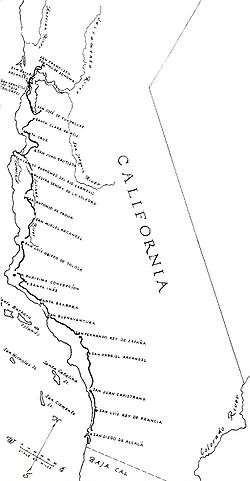Alta California Territory

Alta California Territory (Upper California) was a 19th-century federal territory formed under the Mexican Constitution of 1824. Its boundaries corresponded with those of the preceding Spanish colonial Alta California Province. It included the territory of the present day U.S. states of California, Nevada and Utah and parts of Arizona, Wyoming, Colorado and New Mexico.
History

Before Mexico independence
Between 1683 and 1834, Jesuit and Franciscan missionaries established a series of religious outposts from today's Baja California and Baja California Sur into present-day California.[1][2]
The Spanish missions in Alta California were a series of 21 religious and military outposts established by Catholic priests of the Franciscan order between 1769 and 1833, to spread Christianity among the local Native Americans. The missions were part of the first major effort by Europeans to colonize the Pacific Coast region, the most northern and western of Spain's North American land claims. The El Camino Real road connected the missions from San Diego to Mission San Francisco Solano, in Sonoma, a length of 529 miles. Settlers to the region introduced European fruits, vegetables, cattle, horses, ranching and technology into Alta California.
Independent Mexico
Mexico declared independence from Spain in 1822, upon conclusion of the decade-long Mexican War of Independence (Spain did not acknowledge its independence until 1836). With the establishment of a republican government in 1823, Alta California, was not recognized as one of the constituent States of Mexico because of its small population. The 1824 Constitution of Mexico refers to Alta California as a "territory".
After the Mexican secularization act of 1833 the capital of Alta California Territory was Monterey. After a revolt led by Juan Bautista Alvarado in 1836, the territory was transformed into a Department, which granted it more autonomy.[1][2][3]
Alta California Territory, which comprised much of the present Southwestern United States, was ceded to the United States by Mexico in the Treaty of Guadalupe Hidalgo of 1848, the peace treaty that concluded the Mexican–American War.
See also
- Alta California Province (1802-1824; Spanish colonial period)
- Mexican California-related topics (1822-1848)
- Las Californias Province (1776-1804; Spanish colonial period)
- Conquest of California (Mexican–American War in Alta California)
- History of California through 1899
- Baja California Territory (est. 1824)
On California history:
- Juan Bautista de Anza National Historic Trail
- History of California through 1899
- California 4th Grade Mission Project
- History of the west coast of North America
On general missionary history:
On colonial Spanish American history:
- Spanish colonization of the Americas
- Indian Reductions
- California mission clash of cultures
- Native Americans in the United States
Fictional characters:
References
- 1 2 Ryan, Mary Ellen & Breschini, Gary S. (2010). "Secularization and the Ranchos, 1826-1846". Salinas, CA: Monterey County Historical Society. Retrieved 30 May 2016.
- 1 2 Robinson, William Wilcox (1979). Land in California: The Story of Mission Lands, Ranchos, Squatters, Mining Claims, Railroad Grants, Land Scrip, Homesteads. Chronicles of California, Volume 419: Management of public lands in the United States. Berkeley, CA: University of California Press. p. 29. ISBN 0520038754. Retrieved 30 May 2016. The cortes (legislature) of New Spain issued a decree in 1813 for at least partial secularization that affected all missions in America and was to apply to all outposts that had operated for ten years or more; however, the decree was never enforced in California.
- ↑ Yenne, Bill (2004). The Missions of California. San Diego, CA: Thunder Bay Press. pp. 18f. ISBN 1592233198.
Further reading
| Wikimedia Commons has media related to California missions. |
- Blomquist, L.R., A Regional Study of the Changes in Life and Institutions in the San Luis Obispo District, 1830-1850 (M.A. thesis, History Department, University of California, Berkeley, 1943). Source consulted by Ryan & Breschini (2010).
- Breschini, G.S., T. Haversat, and R.P. Hampson, A Cultural Resources Overview of the Coast and Coast-Valley Study Areas [California] (Coyote Press, Salinas, CA, 1983). Source consulted by Ryan & Breschini (2010).
- Album of Views of the Missions of California, Souvenir Publishing Company, San Francisco, Los Angeles, 1890s.
- The Missions of California, by Eugene Leslie Smyth, Chicago: Alexander Belford & Co., 1899.
- Howser, Huell (December 8, 2000). "Art of the Missions (110)". California Missions. Chapman University Huell Howser Archive.
- California Mission Sketches by Henry Miller, 1856 and Finding Aid to the Documents relating to Missions of the Californias : typescript, 1768–1802 at the Bancroft Library
External links
- California Missions Foundation
- California Mission Studies Association
- California's Spanish Missions
- California Missions
- Library of Congress: American Memory Project: Early California History, The Missions
- Tricia Anne Weber: The Spanish Missions of California
- California Missions
- California Historical Society
- National Register of Historic Places: Early History of the California Coast: List of Sites